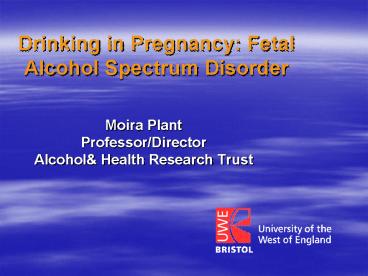Drinking in Pregnancy: Fetal Alcohol Spectrum Disorder - PowerPoint PPT Presentation
1 / 20
Title:
Drinking in Pregnancy: Fetal Alcohol Spectrum Disorder
Description:
Many studies have now shown that heavy drinking by pregnant women is associated ... The Developing Human, Clinically Oriented Embryology (1988). WHEN? ... – PowerPoint PPT presentation
Number of Views:46
Avg rating:3.0/5.0
Title: Drinking in Pregnancy: Fetal Alcohol Spectrum Disorder
1
Drinking in Pregnancy Fetal Alcohol Spectrum
Disorder
- Moira Plant
- Professor/Director
- Alcohol Health Research Trust
2
Drinking in Pregnancy
- Lower Levels of Drinking
- Incidence
- Diagnostic Criteria FAS FAE FASD
- Facial Features
- Older Children
3
Lower Levels of Drinking
- Reduction in birth weight.
- Developmental delays both psychomotor and mental.
- Possible problems at school both behavioural and
with academic performance - e.g.. Attention/memory deficits
4
Alcohol-Related Birth Damage
- Many studies have now shown that heavy drinking
by pregnant women is associated with fetal
abnormalities. - Evidence on low/moderate consumption is mixed.
This is a very emotive subject - Alcohol-related birth damage is associated with a
number of factors, only one of which is alcohol.
5
Whos at higher risk?
- Poverty
- Poor prenatal care
- Poor nutrition and health
- Poly-drug use
- Prostitution (sex trade)
- Parent, partner, peer problems (AD)
- Psychiatric concerns ( mood, anxiety, thought
disorders) - Prior abuse (childhood sexual/- physical)
6
(No Transcript)
7
Incidence of FAS
- In North America 10 per 1,000 live
births Sampson et al 1997 - In UK ?
- Other Countries ?
- A woman who has had one child with FAS and who
continues to drink is at greater risk of
producing another child with FAS - 2nd child 75 risk
- 3rd and subsequent children 90 risk
8
Diagnostic Paradigms
- 1973 Fetal Alcohol Syndrome
- Pre and post natal growth defficiency
- Physical anomalies
- distinctive facial features
- Central nervous system dysfunction
- Severe learning/living difficulties
- Identifiable drinking problem in mother
9
Diagnostic Paradigms
- Fetal Alcohol Effects
- If heavy drinking caused severe damage then
lighter drinking would cause similar damage less
severely - Recently this diagnosis has been dismissed as it
is unhelpful and leads to inaccurate reporting - (Kaskutas 1995)
10
Diagnostic Paradigms
- 1996 Institute of Medicine (US)
- 1)FAS with confirmed maternal alcohol exposure.
- 2) FAS without confirmed maternal alcohol
exposure. - 3) Partial FAS with confirmed alcohol
exposure. - 4) Alcohol-related birth defects.
11
Diagnostic Paradigms
- US Institute of Medicine (Conti)
- 5) Alcohol-related neurodevelopmental disorder.
- This category includes Evidence of a complex
pattern of behaviour or cognitive abnormalities
that are inconsistent with the developmental
level and cannot be explained by familial
background or environment alone----including
learning difficulties and problems related to
memory, attention or judgement
12
Diagnostic ParadigmsFetal Alcohol Spectrum
Disorders (FASD) 2002
- 1) Growth
- 2) Facial features
- 3) Brain
- 4) Maternal Drinking History
13
FAS FACIAL FEATURES
14
WHEN? Critical Periods of Human Development
BRAIN
K.L. Moore. The Developing Human, Clinically
Oriented Embryology (1988).
15
FAS Diagnostic Guide and CD-ROM
16
Alcohol inhibits the let down reflex Changes
the Smell and Taste of Breast Milk
17
Changes with Age
- Facial features become less obvious
- Developmental changes may be negative. IQ may
decrease by up to 15 points between early
childhood and adolescence. - Cognitive and behavioural deficits persists into
adulthood - Steinhausen et al 1994
18
Adult
- Judgement and critical thinking are poor
- Lacks social skills either aggressive or
withdrawn - Blames others for own mistakes
- Involved in criminal activity
- Difficulty in keeping job
- Abusive relationships
- Parenting problems
- Mental health problems
- Depression/ suicide attempts
- Anxious
- Future patients?
19
Secondary Disabilities
- Joblessness
- Homelessness
- Trouble with the law
- Early school drop-out
- Unplanned pregnancies
- Parenting problems
- Mental health concerns
- Alcohol and drug issues
- Sex trade
- HIV risk
- Premature death
- Streissguth et al,1996
20
Protective Factors(Streissguth et al, 1997)
- Stable, nurturing home, 72 of life
- Diagnosis before age 6
- No experience of violence against self increased
risk for Inappropriate Sexual Behavior either
towards them or by them - Staying in each living situation for minimum of
2.8 yrs. (average)






























